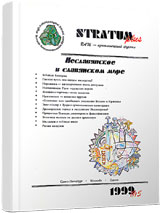Современные данные по варяжской проблеме на фоне традиций русской историографии
Modern Findings Related To the Varangian Issue and Russian Historiographic Traditions
Author(s): Evghenii N. NosovSubject(s): History, Archaeology, Middle Ages, 6th to 12th Centuries
Published by: Издательский дом Stratum, Университет «Высшая антропологическая школа»
Summary/Abstract: Traditional understanding of the Norman problem is based on some interpretation of the Varangian legend of Russian chronicles and on the answers to the question about the role of Varangians in the formation of the Russian state. The approach to the solution of the problem is defined by two tendencies: Russian and Scandinavian. These tendencies had nationalist motivation and were mutually exclusive. However, already among Russian historians of the XIX century: Shakhmatov, Presnyakov, Klyuchevsky, Seredonin and Platonov a realistic approach developed in understanding of the Varangians’ role in Russia. Should the historical science in Russia develop naturally, the Norman problem would have been over by the 30s of the XX century. The reality, however, turned out to be very much different. Science of the Soviet period was dominated by the simplistic Marxist social approaches. External, geographical and trade factors were not taken into consideration. New researches reduced the role of Varangians to a minimum or excluded it altogether. In the late 50s and, especially, early 60s the ideological pressure on science slowed down. New researches appeared showing Scandinavian contribution to the culture of Russia. In 1965 a very important event took place: Norman discussion during the issue-oriented seminars conducted by Leo Klejn at Leningrad University. After that, Scandinavian researches in Russia, especially in Saint-Petersburg, became particularly active. The participants at the seminars: Lebedev, Bulkin, Nosov, Dubov, Nazarenco and others received new rich materials during the excavations. These findings allow addressing Slavonic-Scandinavian relations in the epoch of formation of the Ancient Russia at a new level.
Journal: Stratum plus. Археология и культурная антропология
- Issue Year: 1999
- Issue No: 5
- Page Range: 112-118
- Page Count: 7
- Language: Russian

